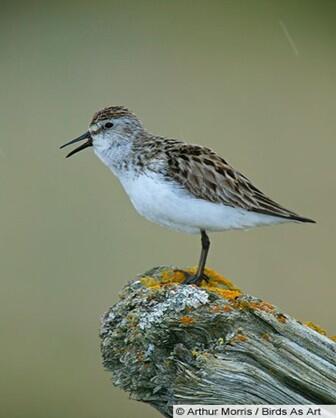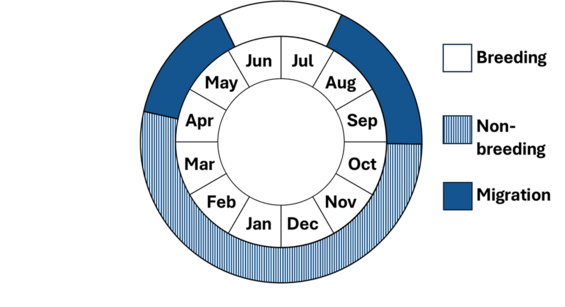- Scientific name: Calidris pusilla
Species of Greatest Conservation Need (MA State Wildlife Action Plan)
Description

Semipalmated sandpiper
The semipalmated sandpiper is a small shorebird, about 15-18 cm (6-7 in) long with a 35-37 cm (14-15 in) wingspan. Breeding adults are brown, black, gold, and rufous above and pale below with dark legs. Non-breeding adults and juveniles are more of a dull gray-brown above but keep the pale below and dark legs. This species is similar in appearance to other species of small sandpipers (e.g., least sandpiper, western sandpiper) and can be hard to identify. No geographic variation in plumage has been described for this bird, although bill length declines from the eastern to western portions of the breeding range. Their name comes from the incomplete webbing between their toes.
Life cycle and behavior

Semipalmated sandpipers are migratory. Their northbound migration begins in April and continues to June. Males arrive on the breeding grounds about a week before females in early June and set up territories almost immediately. Once together, pairs will engage in nest-scraping for several days then create a nest in the ground, lined with grass, sedge, moss, and other vegetation. Four eggs are the average size clutch, and a pair often renest if the first is predated. Both adults incubate the nest for about 19-21 days. Chicks are covered in down and feed themselves within hours of hatching. Females leave the breeding grounds within 11 days of hatch. Males leave the brood shortly before or after chicks fledge. Juveniles depart the breeding grounds several weeks later; flocks of juveniles arrive at staging sites by mid-August and through September. Southbound flocks start arriving on the wintering grounds as early as August. Annual and juvenile survival is understudied, but some studies have suggested an annual adult survivorship of around 70%. The oldest known semipalmated sandpiper was at least 17 years old.
Semipalmated sandpipers feed primarily on small aquatic and marine invertebrates. Their foraging in coastal areas is usually dictated by tidal cycles, as low tide provides more abundant prey. Semi-palmated sandpipers feed by pecking and probing, and western populations have been observed slurping biofilm and ostracods. Horseshoe crab eggs are an important food item during migration. Their diet during the breeding season consists mostly of chironomid larvae, spiders, and other insect and insect larvae.
Population status
There are an estimated 9,000,000-11,000,000 mature individuals. While more research is needed, it is thought that the population has experienced a substantial decline.
Distribution and abundance
Semipalmated sandpipers are found only in the Americas. This species breeds widely in Arctic and subarctic Canada, from the Alaskan coast east to northern Quebec. In the winter they migrate to the northern and central coasts of South America. Flocks will gather in key migration staging areas, and individuals from eastern populations undertake a nonstop transoceanic flight from New England and southern Canada to South America, powered by extensive fat reserves. In spring, eastern breeders follow an Atlantic route from northeastern South America to staging areas along the northeast coast of North America, the interior U.S., and northern Canada, gathering the energy resources to complete migration to their breeding grounds. These annual spring and fall migrations create an elliptical migration route across the Western Hemisphere.
Although declining, semipalmated sandpipers are still one of the most common migrant shorebirds that move through Massachusetts and can be found in large flocks along sandy beaches and mudflats.
Habitat
Semipalmated sandpipers breed in low and sub-arctic tundra near water. They will nest in river deltas in dry shrubby areas with mixed sedges and grasses, sandy areas along rivers, or heath tundra.
During their migrations this species will congregate in staging areas of shallow water, muddy or sandy intertidal zones, along the edges of lakes, or at the junction of short-grass marsh and tidal flats. They will often roost in large numbers on exposed beaches during high tide when marshlands are flooded.
Healthy habitats are vital for supporting native wildlife and plants. Explore habitats and learn about conservation and restoration in Massachusetts.
Threats
It is thought that legal and illegal hunting in the Caribbean and northern South America is a primary cause of this species’ declining population. They are also vulnerable to reduction in their breeding range as a result of climate change. Loss and degradation of coastal and inland wetlands as well as exposure to toxins pose a threat to this species.
Plastic trash in the environment poses a threat as it can be mistaken as food by seabirds and shorebirds and ingested or cause entanglement. Ingested plastics, common for seabirds, can block digestive tracts, cause internal injuries, disrupt the endocrine system, and lead to death. Entanglement from fishing gear and other string-like plastics can cause mortality by strangulation and impairing movements.
Conservation
Many of the existing shorebird conservation efforts benefit semipalmated sandpipers. The Western Hemisphere Shorebird Reserve Network identifies and protects important shorebird sites, any of which are critical to semipalmated sandpiper wintering and staging areas. Continued efforts to protect critical shorebird habitat would benefit this species. Avoid or recycle single-use plastics and promote and participate in beach cleanup efforts.
Research needs
Future research for semipalmated sandpipers should include collecting morphometric data, determining disturbance impacts, and identifying key stopover and wintering areas.
References
BirdLife International. Species factsheet: Semipalmated Sandpiper Calidris pusilla. 2024. https://datazone.birdlife.org/species/factsheet/semipalmated-sandpiper-calidris-pusilla
Hicklin, P. and C. L. Gratto-Trevor. Semipalmated Sandpiper (Calidris pusilla), version 1.0. In Birds of the World (A. F. Poole, Editor). 2020. Cornell Lab of Ornithology, Ithaca, NY, USA. https://doi-org.silk.library.umass.edu/10.2173/bow.semsan.01
Veit, R., and W. Petersen. 1993. Birds of Massachusetts. Massachusetts Audubon Society.
Contact
| Date published: | April 4, 2025 |
|---|